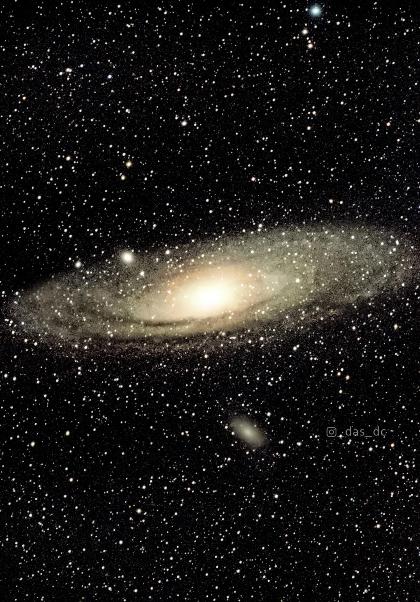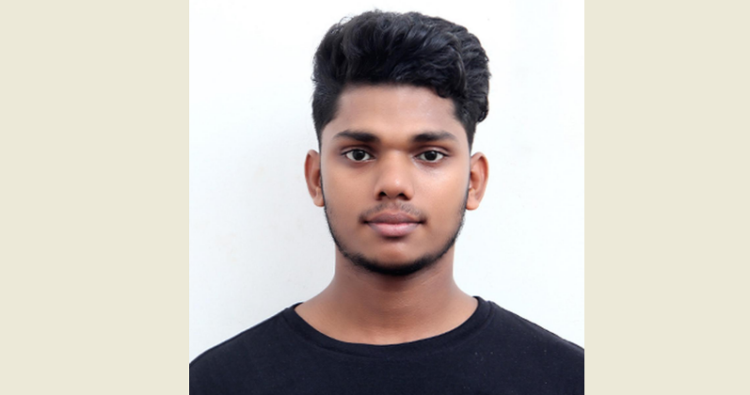Kochi: A.R. Krishnadas, a 23-year-old boy from Fort Kochi, has entered the world of astronomy by photographing Andromeda, another Galaxy, which carries universal wonders and remains 25 lakhs light years off Earth. Efforts behind this achievement are incredible: Sleepless nights for several months together, consistent and nonstop efforts, everything a one man army’s war. A rented ordinary Canon EOS Mark 3 Camera was the comrade-in-arms. That camera photographed thousands of pictures. Andromeda is the Greek name for an Ethiopian princess. Its total area is about two lakhs light years.
Krishnadas is a BBA student in Kochi. The world of science and astronomy has yet to realise the inquisitiveness and interest this boy from an ordinary family has developed in astronomy. No doubt, he is going to be the pride and prestige of the country in the years to come. But, he is badly in need of a sophisticated camera and other equipment, facilities of Astro laboratories, training and other help. Hopefully, the concerned authorities will take the necessary care in this regard.

Krishnadas is the son of Ramdas, a senior Sangh swayamsevak and former Kochi District Ghosh Pramukh.
Krishnadas has been trying to capture pictures of Andromeda for the last few months. He says, he went back 25 lakh years in time. At last, he won the race. What he captured and presented is the picture of galaxy that is 2.5 million light-years away from Earth. It is the most distant object visible with the naked eye. It is the closest major galaxy to the Milky Way and can only be seen in a really dark sky. Interestingly Krishna captured the picture from the rooftop of his house in Amaravathy, Fort Kochi, Ernakulam district, Kerala.
Krishna rented the Canon EOS 5D Mark 3 Camera and a 2.8 200 mm lens from his father’s friend. He says, ‘The Andromeda can be seen from September to December, from 11pm onwards. At 1am it is overhead.’ Krishna spent several nights for capturing the moving galaxy. Kochi suffers the highest light pollution among other cities in the state. And, nights are mostly cloudy. And, he does not have any star tracker, a sophisticated equipment that moves in tune with the stars’ movement. His only option was to adjust the camera manually and keep on photographing the movement.
Kirshna said he has been getting timely advice from Sharat Chandra, Astronomer-cum-Astro Photographer of Kerala. He got abundant encouragement from his father Ramadas, and the photographers’ fraternity. His next target is to capture Saptha Rishi alias Star Karthika. He burnt lot of midnight oil to study astronomy before venturing into his latest initiative.
Sharat says that ‘every celestial object appears to be rising and setting due to earth’s rotation. It is constant state of rotation in the sky. When we use slow shutter speed to capture in faint light from distant celestial objects, we get the star not as a point but as a line. That is called a star trail. Astro Photographers usually use a star tracker to avoid these trails. A basic tracker costs Rs 50,000.’
Since Krishna did not have a tracker, he had to manually click 1,800 shots and use ‘stacking.’ It is a technique where the same composition is shot multiple times and adding them to arrive at a final image using dedicated astrophotography software. Krishna, in his first attempt, took 800 photos, but he was not satisfied with the results. So, tried a second and third time and finally arrived at the photograph which could thrill the astronomers.
Sarath Prabhav, Amateur astronomer, astrophotographer and convenor of ASTRO Kerala (Amateur Astronomers Organisation of Kerala) says, Krishna’s achievement is great. He lauds Krishnadas’ efforts. The Thiruvananthapuram-based astronomer explains that capturing Andromeda from a city is tough due to high light pollution (Bortle 7 to 8 sky). But, the use of basic equipment is also exceptional about the feat. It is just a digital single-lens reflex camera (DSLR) and a tripod. (Bortle is an index used to represent the amount of light pollution in a range of 10).
Sarath calls the image “classic”. He had recently photographed Andromeda using the tracker. The photograph was published in a Malayalam newspaper. That is how Krishna got in touch with him. Sarath encouraged Krishna in his endeavours. Sarath reiterated that Krishna’s Andromeda initiative is remarkable. His patience and painstaking efforts deserve high compliments and kudos.
Reputed Night Sky photographer Ajay Talwar is very much pleased with the innovative initiative of Krishna. He says “People use very expensive mounts, and he has done with minimal equipment and that too from a city.”
He added that photographing Andromeda from a dark location is far easier. In a city, the time and effort are ten to 15 times more.
Krishnadas is proud and happy about his achievement and is all set to start his next venture. It is chasing the Orion Nebula in December.
If concerned authorities take a keen interest in encouraging Krishnadas, the boy will be the country’s pride in the days and years to come.
















Comments